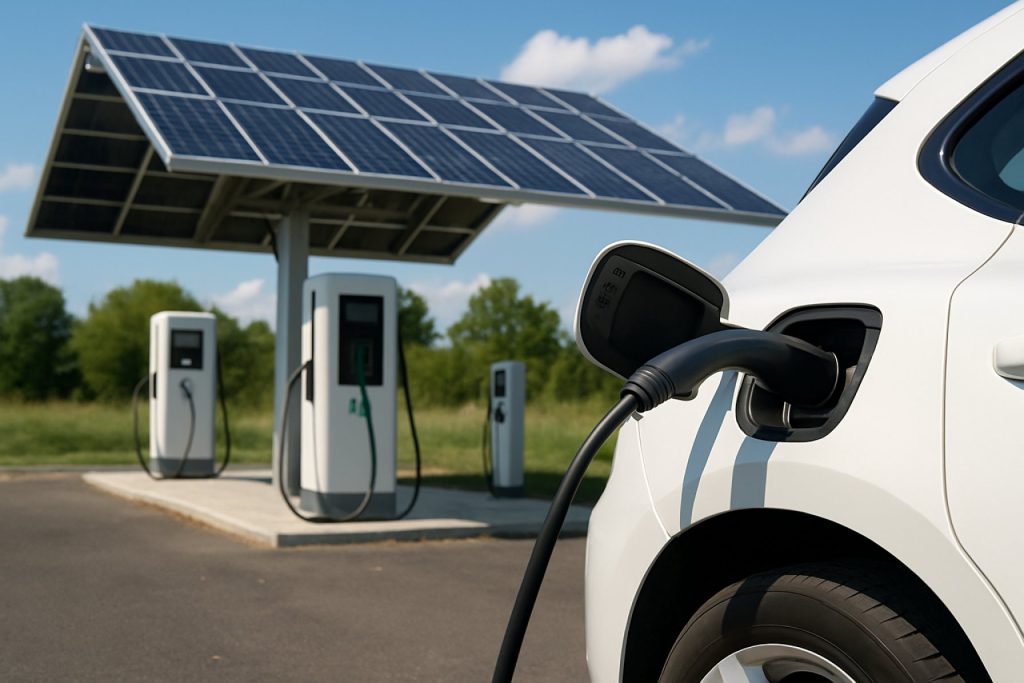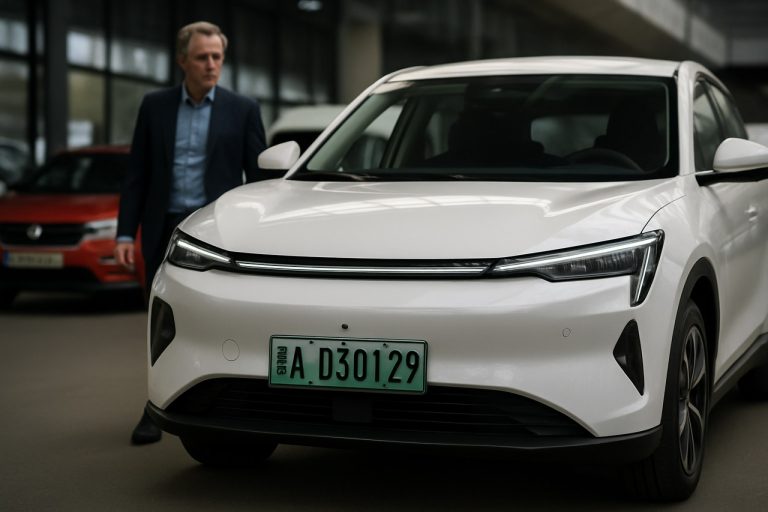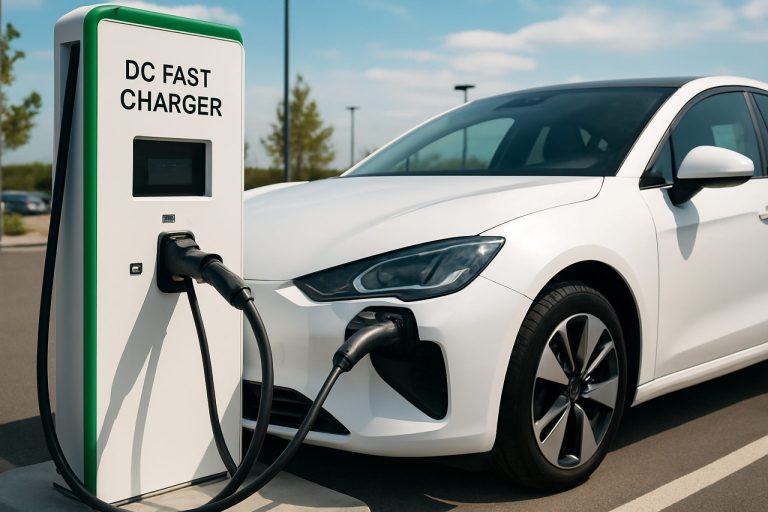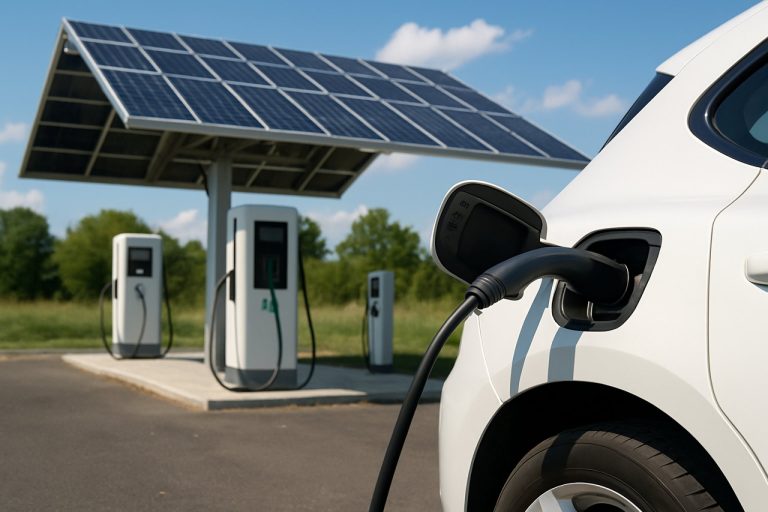
Solar-Powered Charging Stations in 2025: How Next-Gen Infrastructure Is Powering the Future of Sustainable Transportation. Explore Market Growth, Technology Shifts, and the Road Ahead.
- Executive Summary: Key Trends and Market Drivers in 2025
- Global Market Size and Growth Forecast (2025–2030)
- Technological Innovations: Solar Integration and Storage Solutions
- Competitive Landscape: Leading Manufacturers and New Entrants
- Policy, Regulation, and Incentives Shaping the Sector
- Deployment Models: Urban, Highway, and Off-Grid Applications
- Cost Analysis and ROI: CAPEX, OPEX, and Payback Periods
- Case Studies: Successful Installations and Pilot Projects
- Challenges and Barriers: Grid Integration, Reliability, and Scalability
- Future Outlook: Market Opportunities and Strategic Recommendations
- Sources & References
Executive Summary: Key Trends and Market Drivers in 2025
In 2025, solar-powered charging stations are emerging as a pivotal solution in the global transition toward sustainable transportation and renewable energy integration. The convergence of rapid electric vehicle (EV) adoption, grid decarbonization mandates, and advances in photovoltaic (PV) and battery storage technologies is driving significant investment and deployment in this sector. Governments and municipalities are increasingly prioritizing solar-powered infrastructure to meet climate targets and reduce grid dependency, while private sector players are scaling up installations to capture growing demand from both public and commercial fleets.
Key industry leaders such as Tesla, Inc. are expanding their Supercharger networks with solar canopies and integrated battery storage, aiming to provide clean, reliable, and off-grid charging options. Enel S.p.A., through its subsidiary Enel X, is deploying solar-powered charging solutions across Europe and the Americas, focusing on urban centers and highway corridors. ABB Ltd. continues to innovate in modular solar charging systems, targeting both fast-charging and destination charging segments. Meanwhile, BP p.l.c. is investing in solar-powered forecourts and EV charging hubs as part of its broader strategy to transition from fossil fuels to integrated energy solutions.
Recent data indicates a sharp uptick in installations: in 2024, the number of solar-powered public charging stations worldwide surpassed 10,000, with projections suggesting a doubling by 2026 as more cities and fleet operators commit to renewable-powered mobility infrastructure. The integration of energy storage is a defining trend, enabling stations to offer fast charging even during periods of low sunlight and to provide grid services such as peak shaving and demand response. Companies like Tesla, Inc. and Enel S.p.A. are at the forefront of combining solar, storage, and smart charging management to optimize energy use and reduce operational costs.
Looking ahead, the outlook for solar-powered charging stations remains robust. Policy incentives, such as tax credits and renewable energy mandates, are expected to accelerate deployment, particularly in regions with high solar irradiance and ambitious EV targets. Technological advancements in high-efficiency PV panels, bidirectional charging, and digital energy management platforms will further enhance the viability and scalability of these systems. As the sector matures, collaboration between utilities, automakers, and infrastructure providers will be critical to ensuring seamless integration with the broader energy and transportation ecosystems.
Global Market Size and Growth Forecast (2025–2030)
The global market for solar-powered charging stations is poised for significant expansion between 2025 and 2030, driven by the accelerating adoption of electric vehicles (EVs), increasing renewable energy integration, and supportive government policies. As of 2025, the deployment of solar-powered charging infrastructure is gaining momentum in key regions including North America, Europe, and parts of Asia-Pacific, with both public and private sector investments intensifying.
Major automotive and energy companies are actively investing in solar-powered charging solutions. For example, Tesla, Inc. continues to expand its Supercharger network, with select sites integrating solar canopies and on-site battery storage to reduce grid dependency and enhance sustainability. Similarly, BP p.l.c. is scaling up its EV charging business, including solar-powered forecourts, as part of its broader transition to renewable energy. Siemens AG and ABB Ltd. are also prominent players, providing integrated solar charging solutions and smart grid technologies to support the growing demand for clean mobility infrastructure.
In terms of market size, industry sources and company statements indicate that the global installed base of solar-powered EV charging stations is expected to surpass tens of thousands of units by 2025, with compound annual growth rates (CAGR) projected in the double digits through 2030. The expansion is particularly robust in countries with ambitious decarbonization targets and high EV adoption rates, such as Germany, the United States, China, and the United Kingdom. For instance, Shell plc has announced plans to deploy solar-powered charging hubs across Europe and Asia, aiming to support both urban and highway charging needs.
Looking ahead, the market outlook for 2025–2030 is characterized by rapid technological advancements, including higher-efficiency photovoltaic panels, integrated energy storage, and smart charging management systems. These innovations are expected to further reduce the levelized cost of charging and enhance grid resilience. Additionally, partnerships between automakers, utilities, and technology providers are anticipated to accelerate the rollout of solar-powered charging infrastructure globally.
Overall, the period from 2025 to 2030 is set to witness robust growth in the solar-powered charging station market, underpinned by strong policy support, technological innovation, and the ongoing electrification of transport. Leading industry players such as Tesla, Inc., BP p.l.c., Siemens AG, ABB Ltd., and Shell plc are expected to play pivotal roles in shaping the global landscape.
Technological Innovations: Solar Integration and Storage Solutions
In 2025, solar-powered charging stations are at the forefront of technological innovation, driven by the convergence of advanced photovoltaic (PV) integration and next-generation energy storage solutions. The global push for decarbonization and the rapid adoption of electric vehicles (EVs) have accelerated the deployment of solar-powered charging infrastructure, with a focus on maximizing efficiency, reliability, and grid independence.
Leading manufacturers are integrating high-efficiency solar panels with smart inverters and modular battery storage systems to enable 24/7 charging capabilities, even during periods of low sunlight or grid outages. Tesla, Inc. continues to expand its Supercharger network with solar canopies and on-site battery storage, leveraging its expertise in both solar technology and lithium-ion battery systems. The company’s approach combines proprietary solar panels with the Tesla Powerpack and Megapack storage units, allowing for energy buffering and peak shaving, which reduces grid strain and operational costs.
Similarly, Enel S.p.A., through its subsidiary Enel X, is deploying solar-powered charging stations across Europe and the Americas. Enel’s solutions integrate bifacial solar modules—capable of capturing sunlight from both sides—with advanced energy management software. This enables dynamic load balancing and real-time optimization of energy flows between solar generation, storage, and EV charging demand.
In Asia, State Grid Corporation of China is piloting large-scale solar charging hubs that combine distributed PV arrays with grid-scale battery storage. These hubs are designed to support the country’s ambitious EV targets and reduce reliance on coal-based electricity during peak charging hours. The integration of vehicle-to-grid (V2G) technology is also being explored, allowing EVs to discharge stored energy back to the grid, further enhancing grid stability and renewable energy utilization.
Key technological trends shaping the sector in 2025 include the adoption of perovskite and tandem solar cells, which offer higher conversion efficiencies and improved performance in low-light conditions. Battery storage is also evolving, with lithium iron phosphate (LFP) and emerging solid-state chemistries providing greater safety, longevity, and scalability for charging station applications.
Looking ahead, the outlook for solar-powered charging stations is robust. Industry leaders are investing in AI-driven energy management systems, predictive maintenance, and seamless integration with renewable microgrids. These innovations are expected to drive down costs, enhance user experience, and accelerate the transition to a sustainable, electrified transportation ecosystem.
Competitive Landscape: Leading Manufacturers and New Entrants
The competitive landscape for solar-powered charging stations in 2025 is characterized by a dynamic mix of established manufacturers, innovative technology firms, and new market entrants. As the global push for clean mobility intensifies, companies are racing to expand their portfolios and geographic reach, leveraging advances in solar technology, battery storage, and smart grid integration.
Among the leading manufacturers, Tesla, Inc. continues to play a pivotal role. Tesla’s Supercharger network, while primarily grid-powered, has seen increasing integration of solar canopies and on-site energy storage, particularly in North America and Europe. The company’s vertical integration—from solar panels to battery storage and charging hardware—positions it as a formidable player in the solar-powered charging segment.
Another major player is ABB Ltd., a global leader in electrification and automation. ABB has developed solar-integrated EV charging solutions, including fast chargers with photovoltaic (PV) support and energy management systems. Their focus on modular, scalable infrastructure has enabled deployments in both urban and remote locations, supporting public and fleet charging needs.
In Asia, Sungrow Power Supply Co., Ltd. has emerged as a significant supplier of solar inverters and integrated solar charging stations. Sungrow’s solutions are widely adopted in China and expanding into Europe, leveraging their expertise in PV technology and energy storage to offer turnkey solar charging systems.
New entrants are also shaping the competitive landscape. Startups such as Volta Inc. are deploying solar-powered charging stations with a focus on high-visibility urban locations and innovative business models, such as ad-supported charging. Meanwhile, companies like Enel X are integrating solar generation with smart charging platforms, targeting both commercial and residential markets.
Industry alliances and partnerships are accelerating innovation. For example, collaborations between automakers, energy companies, and technology providers are driving the deployment of solar-powered charging corridors along major highways and in underserved regions. The competitive environment is further intensified by government incentives and regulatory mandates in the US, EU, and Asia-Pacific, which are spurring both incumbents and newcomers to scale up production and deployment.
Looking ahead, the market is expected to see increased competition as battery costs decline, solar panel efficiencies improve, and digital platforms enable smarter energy management. The convergence of solar, storage, and EV charging technologies is likely to foster new business models and partnerships, reshaping the competitive landscape through 2025 and beyond.
Policy, Regulation, and Incentives Shaping the Sector
Policy, regulation, and incentives are playing a pivotal role in shaping the deployment and growth of solar-powered charging stations as the world accelerates its transition to clean mobility. In 2025, governments and regulatory bodies are increasingly integrating solar charging infrastructure into broader decarbonization and electric vehicle (EV) adoption strategies. The European Union, for example, has reinforced its Alternative Fuels Infrastructure Regulation (AFIR), which mandates member states to expand public charging networks, with a growing emphasis on renewable energy integration. This regulatory push is encouraging the installation of solar-powered charging stations across urban and highway corridors, aligning with the EU’s Fit for 55 package and its 2030 climate targets (European Union).
In the United States, the Inflation Reduction Act (IRA) continues to provide significant tax credits and incentives for both solar energy systems and EV charging infrastructure. The federal Investment Tax Credit (ITC) remains a key driver, offering up to 30% tax credit for solar installations, including those paired with EV charging. Additionally, the National Electric Vehicle Infrastructure (NEVI) Formula Program allocates billions in funding to states, with eligibility criteria that increasingly favor renewable-powered charging solutions (U.S. Department of Energy). Several states, such as California and New York, have introduced their own grant programs and mandates to prioritize solar-powered and grid-resilient charging stations, further accelerating market adoption.
In Asia, China’s central and provincial governments are actively supporting the integration of solar with EV charging, as part of their dual carbon goals. Subsidies, land-use incentives, and grid interconnection policies are being tailored to encourage solar-powered charging, especially in new energy vehicle (NEV) demonstration zones. Major Chinese EV and solar companies, such as BYD Company Limited and State Grid Corporation of China, are collaborating on pilot projects and large-scale rollouts of solar-integrated charging infrastructure.
Looking ahead, policy frameworks are expected to become more prescriptive, with requirements for renewable energy sourcing and energy storage integration at charging sites. Industry bodies such as International Energy Agency and International Renewable Energy Agency forecast that regulatory alignment and incentive harmonization will be crucial for scaling solar-powered charging, especially as grid decarbonization and EV adoption accelerate through 2030. The convergence of climate policy, clean energy incentives, and EV infrastructure mandates is set to make solar-powered charging stations a central pillar of sustainable mobility in the coming years.
Deployment Models: Urban, Highway, and Off-Grid Applications
Solar-powered charging stations are increasingly being deployed across diverse environments, with distinct deployment models emerging for urban, highway, and off-grid applications. As of 2025, these models are shaped by advances in photovoltaic technology, battery storage, and the growing demand for sustainable electric vehicle (EV) infrastructure.
Urban Deployment: In cities, solar-powered charging stations are primarily integrated into existing parking lots, commercial centers, and public spaces. Urban installations often feature solar canopies that provide both shade and energy generation, maximizing the use of limited space. Companies such as Tesla, Inc. and ABB Ltd. are actively involved in deploying urban solar charging solutions, with Tesla’s Supercharger network increasingly incorporating solar arrays and battery storage to reduce grid dependency. Urban deployments benefit from proximity to grid infrastructure, allowing for hybrid systems that combine solar generation with grid backup, ensuring reliability during periods of low sunlight.
Highway Deployment: Along highways, solar-powered charging stations are being established at rest stops and service areas to support long-distance EV travel. These stations typically require higher power output and rapid charging capabilities. Enel S.p.A., through its subsidiary Enel X, is expanding solar-powered fast-charging corridors across Europe and North America, often integrating energy storage to manage peak demand and provide grid services. Highway deployments are strategically located to minimize range anxiety and are increasingly supported by government initiatives aimed at decarbonizing transportation infrastructure.
Off-Grid Applications: In remote or underserved regions, off-grid solar-powered charging stations are crucial for enabling EV adoption where grid access is limited or unreliable. These stations rely entirely on solar panels and battery storage, sometimes supplemented by small-scale wind or backup generators. Companies like BYD Company Ltd. and Siemens AG are developing modular, containerized solar charging solutions that can be rapidly deployed in off-grid locations. Such systems are particularly valuable in rural areas, islands, and developing markets, supporting both passenger vehicles and electric two- and three-wheelers.
Looking ahead, the deployment of solar-powered charging stations is expected to accelerate through 2025 and beyond, driven by falling solar and battery costs, supportive policies, and the electrification of transport. Urban, highway, and off-grid models will continue to evolve, with increased integration of smart energy management and vehicle-to-grid technologies, further enhancing the resilience and sustainability of EV charging infrastructure.
Cost Analysis and ROI: CAPEX, OPEX, and Payback Periods
The cost structure and return on investment (ROI) for solar-powered charging stations in 2025 are shaped by several factors, including capital expenditure (CAPEX), operational expenditure (OPEX), and the evolving economics of solar and battery technologies. As the electric vehicle (EV) market expands and grid decarbonization accelerates, solar-powered charging infrastructure is increasingly viewed as a strategic investment for both public and private stakeholders.
CAPEX for solar-powered charging stations typically includes the costs of photovoltaic (PV) panels, inverters, mounting structures, energy storage systems (if included), EV charging hardware, site preparation, and installation. According to leading manufacturers such as Tesla, Inc. and ABB Ltd., the cost of solar PV modules has continued to decline, with utility-scale solar installations averaging below $1 per watt in many regions by 2025. For a typical Level 2 solar-powered charging station with integrated storage, total installed costs can range from $50,000 to $150,000, depending on system size, battery capacity, and site-specific factors. Fast-charging (DCFC) stations with solar integration and substantial battery storage can exceed $250,000 in CAPEX, especially in urban or high-demand locations.
OPEX for these stations is generally lower than grid-only charging sites, as solar generation reduces electricity purchases and mitigates exposure to peak demand charges. Routine maintenance for PV panels and inverters is minimal, and battery systems require periodic inspection and replacement over their lifespan. Companies like Enel X and Siemens AG report that annual OPEX for solar-powered charging stations can be 20–40% lower than conventional grid-tied stations, primarily due to reduced energy costs and fewer moving parts.
Payback periods for solar-powered charging stations in 2025 are highly site-dependent but are trending downward as technology costs fall and utilization rates rise. In regions with high solar irradiance and robust EV adoption, payback periods of 5–8 years are increasingly common, especially when stations benefit from government incentives, renewable energy credits, or participation in demand response programs. For example, Tesla, Inc. and ChargePoint Holdings, Inc. have highlighted projects where solar-powered charging sites achieve positive cash flow within 6 years, particularly when paired with battery storage to maximize self-consumption and grid services revenue.
- Declining solar and battery costs are compressing CAPEX and accelerating ROI.
- OPEX advantages are amplified in regions with high grid electricity prices or demand charges.
- Government incentives and carbon credits can further shorten payback periods.
Looking ahead, the outlook for solar-powered charging stations remains positive, with continued cost reductions, improved energy management software, and growing policy support expected to further enhance financial returns through the late 2020s.
Case Studies: Successful Installations and Pilot Projects
In recent years, solar-powered charging stations have transitioned from pilot concepts to operational infrastructure, with several high-profile case studies demonstrating their viability and scalability. As of 2025, these installations are not only supporting electric vehicle (EV) adoption but also contributing to grid resilience and renewable energy integration.
One notable example is the deployment of solar-powered EV charging stations by Tesla, Inc.. Tesla’s Supercharger network has incorporated solar canopies at select locations, particularly in regions with high solar irradiance. These installations combine photovoltaic panels with battery storage, enabling fast charging while reducing reliance on the grid during peak hours. Tesla’s approach demonstrates how solar integration can enhance the sustainability of high-usage charging corridors.
Another significant case is the collaboration between Enel and ABB in Europe. Enel X, the advanced energy services arm of Enel, has rolled out solar-powered charging stations in Italy and Spain, often in partnership with municipalities. These projects typically feature modular solar canopies and smart energy management systems, allowing for dynamic load balancing and integration with local renewable generation. ABB, a global leader in electrification, supplies fast-charging hardware and digital solutions for these sites, ensuring interoperability and scalability.
In the United States, Blink Charging Co. has piloted solar-powered charging stations in public parking lots and university campuses. Their installations utilize solar arrays mounted on carports, providing both shade and clean energy for EV charging. Blink’s projects have demonstrated the feasibility of off-grid and grid-tied configurations, with some sites incorporating battery storage to enable 24/7 operation and demand response capabilities.
Asia has also seen rapid progress. Tata Power in India has launched solar-powered charging stations in major cities, supporting the country’s push for clean mobility. These stations are often co-located with commercial centers and use locally manufactured solar panels, aligning with national renewable energy targets.
Looking ahead, the success of these pilot projects is informing larger-scale rollouts. Industry stakeholders are increasingly focused on integrating solar generation, storage, and smart charging to create resilient, low-carbon charging networks. As costs for solar and battery technologies continue to decline, the outlook for solar-powered charging stations remains strong, with further expansion expected across North America, Europe, and Asia through 2025 and beyond.
Challenges and Barriers: Grid Integration, Reliability, and Scalability
Solar-powered charging stations are increasingly recognized as a sustainable solution for electric vehicle (EV) infrastructure, but their widespread deployment faces several challenges related to grid integration, reliability, and scalability. As of 2025, these barriers are shaping the pace and nature of adoption worldwide.
Grid Integration remains a primary concern. Solar charging stations, especially those designed for fast charging, can create significant load fluctuations on local grids. The intermittent nature of solar generation complicates the balancing of supply and demand, particularly during peak usage or cloudy periods. Leading manufacturers such as Tesla, Inc. and ABB Ltd. are developing integrated battery storage solutions to buffer these fluctuations, but the cost and complexity of such systems remain high. Utilities and grid operators are also working to update interconnection standards and invest in smart grid technologies to better accommodate distributed solar assets.
Reliability is another critical barrier. Solar-powered stations depend on weather conditions, which can lead to inconsistent charging availability. While companies like Enel S.p.A. and Siemens AG are piloting hybrid systems that combine solar, grid, and battery storage to enhance uptime, the technology is still maturing. Maintenance of solar panels, inverters, and storage systems adds operational complexity, especially in remote or high-traffic locations. Ensuring 24/7 reliability comparable to conventional grid-tied stations is a key technical and economic hurdle.
Scalability is constrained by both physical and regulatory factors. Large-scale deployment requires significant land or rooftop space for solar arrays, which is not always available in urban or high-demand areas. Furthermore, permitting processes and local regulations can slow installation timelines. Companies such as ChargePoint Holdings, Inc. and BP p.l.c. (through its BP Pulse division) are exploring modular and prefabricated station designs to accelerate rollout, but widespread adoption will depend on streamlined permitting and supportive policy frameworks.
Looking ahead, the outlook for overcoming these challenges is cautiously optimistic. Advances in battery storage, smart grid integration, and hybrid energy systems are expected to improve reliability and grid compatibility. However, addressing land use, regulatory, and cost barriers will require coordinated efforts among technology providers, utilities, and policymakers. The next few years will be pivotal in determining whether solar-powered charging stations can scale to meet the growing demands of the EV market.
Future Outlook: Market Opportunities and Strategic Recommendations
The outlook for solar-powered charging stations in 2025 and the following years is shaped by accelerating electric vehicle (EV) adoption, grid decarbonization goals, and technological advancements in both solar and battery storage. As governments and corporations intensify commitments to net-zero emissions, solar-powered charging infrastructure is positioned as a critical enabler for sustainable mobility and energy resilience.
Key automotive manufacturers and energy companies are investing in solar-integrated charging solutions. Tesla, Inc. continues to expand its Supercharger network, with select sites incorporating solar canopies and on-site battery storage to reduce grid dependency and operational costs. Similarly, BP and its subsidiary BP Pulse are piloting solar-powered charging hubs in Europe, aiming to scale these models as part of their broader renewable energy transition. Shell is also deploying solar panels at select retail sites, integrating EV charging with on-site renewable generation.
In the United States, the National Renewable Energy Laboratory (NREL) projects that by 2025, distributed solar-powered charging stations could supply a significant share of public EV charging demand, especially in regions with high solar irradiance. The integration of energy storage systems is expected to enhance reliability and enable time-shifting of solar energy, addressing intermittency and peak demand challenges. Companies like ChargePoint Holdings, Inc. and EVBox are developing modular charging solutions that can be paired with solar arrays and batteries, targeting commercial fleets, retail centers, and municipal sites.
Strategically, stakeholders should prioritize:
- Site selection in high-traffic, high-solar-potential areas to maximize utilization and energy yield.
- Partnerships between utilities, solar developers, and charging network operators to streamline permitting, grid interconnection, and financing.
- Integration of smart energy management systems to optimize charging schedules, leverage dynamic pricing, and support vehicle-to-grid (V2G) capabilities.
- Exploration of innovative business models, such as energy-as-a-service or subscription-based charging, to enhance revenue streams and user engagement.
Looking ahead, the convergence of falling solar module costs, improved battery economics, and supportive policy frameworks is expected to drive rapid deployment of solar-powered charging stations. As the sector matures, leading companies—such as Tesla, Inc., BP, Shell, ChargePoint Holdings, Inc., and EVBox—are likely to shape best practices and set new standards for sustainable, resilient EV charging infrastructure.
Sources & References
- Enel S.p.A.
- ABB Ltd.
- BP p.l.c.
- Siemens AG
- Shell plc
- Volta Inc.
- Enel X
- European Union
- BYD Company Limited
- International Energy Agency
- Enel S.p.A.
- Enel X
- Siemens AG
- ChargePoint Holdings, Inc.
- Blink Charging Co.
- Tata Power
- ChargePoint Holdings, Inc.
- EVBox



